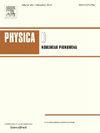引力波湍流中的非对称双级联
IF 2.7
3区 数学
Q1 MATHEMATICS, APPLIED
引用次数: 0
摘要
在强局部四次相互作用的极限下,我们数值模拟了由引力波湍流动力学方程导出的四阶非线性扩散方程。当一个强迫作用于中间波数ki时,我们观察到能量和波作用的双重级联。在稳定状态下,相关通量比与ki成正比,并且恢复了Kolmogorov-Zakharov光谱。研究表明,在衰减湍流中,波作用谱可以扩展到大于初始激励ki的波数,且通量为负,而能量通量为正,且与k呈幂律关系。这导致了一个意想不到的结果:单个惯性范围内,Kolmogorov-Zakharov波作用谱逐步扩展到大于ki的波数。我们还观察到波的作用在t - 1/3处随时间衰减,而能谱的前端则按照t - 1/3的规律发展。这些性质可以用简单的理论论证来理解。本文章由计算机程序翻译,如有差异,请以英文原文为准。
Asymmetric dual cascade in gravitational wave turbulence
We numerically simulate, in both the forced and decay regimes, a fourth-order nonlinear diffusion equation derived from the kinetic equation of gravitational wave turbulence in the limit of strongly local quartic interactions. When a forcing is applied to an intermediate wavenumber , we observe a dual cascade of energy and wave action. In the stationary state, the associated flux ratio is proportional to , and the Kolmogorov–Zakharov spectra are recovered. In decaying turbulence, the study reveals that the wave action spectrum can extend to wavenumbers greater than the initial excitation with constant negative flux, while the energy flux is positive with a power law dependence in . This leads to an unexpected result: a single inertial range with a Kolmogorov–Zakharov wave action spectrum extending progressively to wavenumbers larger than . We also observe a wave action decay in time in while the front of the energy spectrum progresses according to a law. These properties can be understood with simple theoretical arguments.
求助全文
通过发布文献求助,成功后即可免费获取论文全文。
去求助
来源期刊

Physica D: Nonlinear Phenomena
物理-物理:数学物理
CiteScore
7.30
自引率
7.50%
发文量
213
审稿时长
65 days
期刊介绍:
Physica D (Nonlinear Phenomena) publishes research and review articles reporting on experimental and theoretical works, techniques and ideas that advance the understanding of nonlinear phenomena. Topics encompass wave motion in physical, chemical and biological systems; physical or biological phenomena governed by nonlinear field equations, including hydrodynamics and turbulence; pattern formation and cooperative phenomena; instability, bifurcations, chaos, and space-time disorder; integrable/Hamiltonian systems; asymptotic analysis and, more generally, mathematical methods for nonlinear systems.
 求助内容:
求助内容: 应助结果提醒方式:
应助结果提醒方式:


